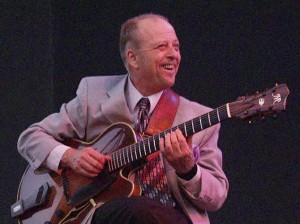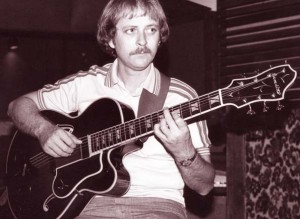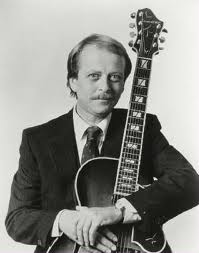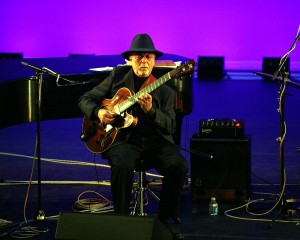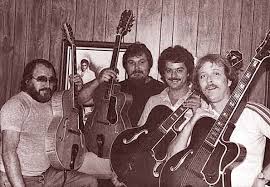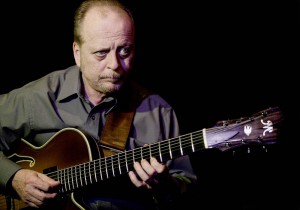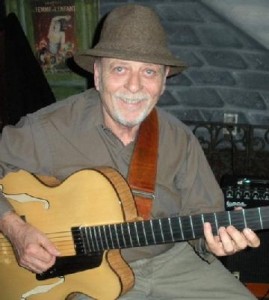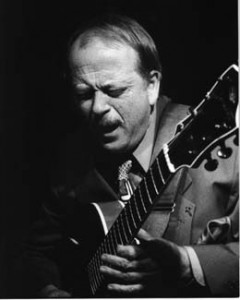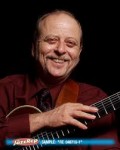
I (Doug Perkins) interviewed Ron Eschete over the phone at a rare hole in between his busy teaching and live gig schedule. Ron was one of the original instructors at Hollywood’s Guitar Institute of Technology (GIT) which later became Musician’s Institute know around the world today, which is where I had originally met him when I was both a student and later instructor. He is a literal master of chord melody and accompaniment on guitar, and has played with jazz royalty including Dizzy Gillespie, Ella Fitzgerald, Diana Krall, Ray Brown, and many more. I knew he’d lived a really interesting life all over the country playing with everyone, and so I was really looking forward to learning a lot more than I already knew about him:
DP: I wanted to start with the typical question: “What made you choose the guitar as your instrument of choice?â€.
RE: Well, we had a little piano at the house and I started beatin’ on that, and…I don’t know, the guitar just seemed more alluring, what made it difficult is what made it good. It took two hands to make a note and you could get a little more expression out if it, and like all the other kids on the block, I wanted to be Ricky Nelson and Elvis Presley, you know…
DP: Yup! (Laughing)
RE: And the piano lasted about 6 months and then I said, “I don’t want to do that, I want to learn how to do THISâ€, so I went to the guitar.
DP: OK, so you started with Ricky Nelson and Elvis, but after THAT, who where the main guys that did it for you?
RE: Well, I started with the blues – you know, Muddy Waters, Jimmy Reed, and all the funk stuff that was around, you know, Wilson Picket and James Brown and all that kind of stuff., Ray Charles, you know. And then I was at a music store in my hometown and I heard Howard Roberts on the Victrola and I said “What is THAT?â€
DP: (Chuckles)
RE: So I went over there and I bought that record “Color Him Funkyâ€, you know, like 1963, and I bought all of his records after that, and got into Wes (Montgomery) and all the cats, you know? Then by the time I was 18 or 19 I had been though all the guitar players, so I went for the piano players.
DP: So where was your hometown?
RE: Houma, Louisiana, 58 miles southwest of New Orleans. I went to college at Loyola in New Orleans.
DP: So describe some of your first gigs, what kind of stuff were you doing?
RE: Well, I used to get calls from some of the country guys because I was the only guy in town that did not use a capo.
DP: That’s hilarious!
RE: I’d do country gigs and go play for them and they’d give me $2 or $5 and a chicken dinner, you know.
DP: Some of the VFW Posts and that sort of thing?
RE: Yeah, and some country clubs and places that served food that I could get into.
DP: What age were you when you were doing this stuff?
RE: Well, I started playing when I was 14 so I guess I was 15.
DP: And when did you start teaching?
RE: About 1971.
DP: What about some of your first more professional gigs, what were you doing?
RE: I was doing casuals in New Orleans. My teacher Mr. Guma had a six night a week gig, and he couldn’t make it sometimes and I knew a lot of tunes. As a kid I used to sit in the backyard with my sister who was 8 years older than me, and we used to sing tunes, you know, like “Stranger In Paradiseâ€, “On The Street Where You Liveâ€, Cole Porter, you know. She was in the high school plays, “Oklahomaâ€, “West Side Story†and all that stuff, so we sang all of those tunes, and I was about 6 years old then. So then when I started playing, heck, I knew a couple of hundred tunes.
DP: Right, you knew the melodies and all you had to do was figure out the changes. So tell me more about your teacher Mr. Guma.
RE: He played classical, he played, jazz, and he also played clarinet in the symphony, he really was a master musician. He showed me how to get a good sound out of the instrument, I can still get a good sound out of a classical guitar.
DP: OK, so now you’re through school and everything – your career has brought you to play with everyone from Dizzy to Ella to Diana Krall and lots more – how did all of that come about?
RE: Well, you know, it’s very strange – after college I moved out to LA with a comedy song act I was working with in New Orleans, Freddie Bell and Laverna Lyn. And I ended up staying out her and did some top 40 with my wife (Carol) and a trio. And did some folk music for a while, all kinds of stuff, and then a got a gig at a place called Hungry Joes in Huntington Beach in about ’74, that was with Dave Pike, and I got to play with a lot of people on the weekend where people like Warren Marsh and people like that would come in as guests and we’d back them up.  (http://articles.latimes.com/1998/oct/15/entertainment/ca-32600 ) So I guess my name got booted around and then I was doing the NAMM show for Polytone and Ray Brown came and sat in, he played Polytone you know. So about a week later I got a call from him – he called me “Ash†short for “Ashtray†instead of Eschete, you know…
DP: (Laughs)
RE: …and he says “do you want to come with me to Seattle with Milt Jackson and Plas Johnson and Frankie Saverino, and I said, “Where’s my ticket? Let’s go!â€. So I started doing that with him – I guess I was kind of like the “3rd call piano player†– he used Monty Alexander and Cedar Walton, and then sometimes he used me, so the three of us sort of split the gig. So anyways, I got into that circle and Dizzy used to come and play with us, and I had already been playing with Gene Harris, I played a whole year with him in ‘75 at Hungry Joes 5 nights a week. And about ’76 I was working at Donte’s with my trio with John Perett and Luther Hughes, and Hampton Hawes walked in and so we took a break and I went up to him and said “Mr. Hawes, I wanted to meet you, I love your playing†and everything, and he shook my hand and said “Hey kid, you wouldn’t know where I could get a guitar trio to back me up on some concerts, would you?â€. I said “ are you kidding me?†and he said “No, here’s my phone number.â€, and so we worked with him off and on for like a year or so backing him up.
So that was that and one thing leads to another, I played with Ella on a couple of occasions at the Hollywood Bowl. I played with Sarah Vaughn and Carmen McRae, they used to come and sit in at Dontes every now and then. I played with Morgana King and Mark Murphy…..and I played with some great local guys,  especially Warren Marsh, who’s my favorite player, I used to follow him around like a little puppy dog hoping some of his greatness would rub off on me.
DP: So how did the GIT thing happen – did you know Howard (Roberts)?
RE: Well, I knew him, I met him a couple times – I went to a seminar that he gave and I walked in and paid my tuition and Joe Diorio was there – and they had already hired Joe, because Joe had just moved out from back east. Anyway, Pat (Hicks) said to Howard, “This is Ronnie Eschete, he’s got some transcriptions of yours.†And so Howard said “well, can you play any of them?â€, so I just went up there with my Howard Roberts model (Epiphone) and just whooped the shit out of a bunch of his things! (laughs) You know? And he’s just sitting there looking at me and he looks at Pat and says “you gotta hire this guy!â€. So anyways that’s how I got the gig and he knew Donnie Mock from seminars up in Seattle. So that’s how the original trio of us guys started- Howard, and then Joe and I and Don – and Jackie King, from down south. Then after he left, Les (Wise) took his place, so that’s how all of that got started.
DP: Now you and Les (Wise) have known each other a long time, I think that Les said that you guys sort of met on the street….
RE: Yeah, I was playing the Jamaican Village on Rampart Ave. in New Orleans, and he came by – I was playing a little (Gibson ES) 330 and he was playing a BEAUTIFUL cherry red (Gibson) Johnny Smith. Let’s see, I was 18 – Les and I were best buddies since I was 18.
DP: I always here blues in your playing – did you ever do the solid body blues thing, or was it always from a jazz point of view?
RE: Well, I did that because I came up with the Beatles and all that stuff, but I played it on my 330. It was a good cross over instrument.
DP: Yeah, I love those guitars actually.
RE: Yeah, you know, guys would come up to me and say â€you played all of these beautiful polychords and bebop, and then you played this nasty blues lick – where did you learn how to play the blues?†And I said, “I NEVER learned how to play the blues – I could ALWAYS play the blues.â€
DP: (laughs)
RE: Because of my environment, you walked down the street and there was a guy with a Jews harp and a guy with a guitar, playing the blues with a slide on their front porch. You know, that was commonplace – a lot of guys played guitar and harmonica.
DP Right! So you did MI for a while, you were there decades weren’t you?
RE: Yeah, 23 tears I was there.
DP: Wow – so post MI, catch me up on that.
RE: Well I went to CalState Fullerton and CalState Long Beach, I’m one of the jazz instructors at both of those places.
DP: And you’re still doing those, so that’s great. What about your trio, you gave me a great live record of that….
RE: Yeah, that was “In The Middleâ€â€¦
DP: I love the bass player on that, Todd Johnson…
RE: Yeah, and Kendall Kay on drums.
DP: So what is coming up for you right now?
RE: Well, next week I am going to Colgate University to do a seminar, my friend Dr. Glenn Cashman runs that music department. So I’m going up there and he’s going to play organ and saxophone, he’s a great saxophone player too. It’s about an hour and a half outside of Syracuse NY.
DP: So the seminar’s going to have a concert with it?
RE: Yeah, there will be a concert and then the seminar is the next day.
DP: I remember we were talking about Chick Corea the other day about one of the things that you played in the JGS master class video you did and you said “I learned that from Chick Corea†– what piano players have you studied?
RE: Well, the most important one was Bill Evans – from the time I was 19 until way into my 30s, I was just stealing stuff from him. I put a lot of my teaching on that, based on his root motion and stuff like that – he was a genius.
DP: Speaking of root motion – what made you decide to go to 7 string?
RE: Practicality. I wasn’t trying to be different or be George Van Eps or anything like that, I was doing a lot of work with just flute, just vocal, or just saxophone, and doing walking bass lines and stuff, so it was a practical thing for me to do that would get me work, which it did.
DP When did you start, and what guitar did you start with?
RE: 1981 or 82. That was a Benedetto – that was Bob’s.
DP: And what do you play now?
RE: I have a CB Hill (http://www.cbhillguitars.com/ ) – it’s the size of a Les Paul but hollow with a very thick maple top. Mahogany back and sides and neck, rosewood fingerboard – all the rest is rosewood, which I’ve been wanting for years – AND it’s a short scale like my old Howard Roberts : 24.62.
DP: What about the pick-up that’s on there?
RE: It’s an EMG 91, which I helped pioneer. My friend Rob Turner at EMG, he’s the one that used to work on my amplifier 35 years ago. As a matter of fact, if you look in the book, he gives me credit – go figure! (http://www.emgpickups.com/ )
DP: And are you still playing Polytones? What’s you amp?
RE: No, I haven’t played Polytones since about ’98. I found an Evans amp and I fell in love with it and have had one ever since, it’s like a Polytone on steroids.
DP: What else do you want people to know?
RE: Well, string wise I play GHS, and I have a special set. If you have any 7 string players out there, I did a lot of research on that, you know, to get a clean sound. All the other 7 string players out there, the guitar just sounds like a regular 6 string and then a big bass string. And I didn’t want that sound, so I experimented with a lot of strings which GHS was kind enough to help me with. And I ended up with the first two strings plain, and the next three flat wound. Then the sixth string is what’s called a bright flat, and the seventh is a boomer, you know, round wound. So as you play and you barre all seven strings, they all sound even because they get brighter as they go down. I use the biggest boomer they make, which is a 0.70. A lot of guys say you need at least an 0.80 to grab that A, but not if you have an EMG pick up – if you have an EMG pick up it will grab anything! (laughs).
DP: I know that you are doing some new right hand stuff for picking that is kind of unique, tell people about that.
RE: Well, I’ve been with Strum N Comfort for a while (http://www.strum-n-comfort.com/ ), they make the Sharktooth and the Kodiak, which is shaped like a shark tooth. I started off with a pretty thick pick, but then I started using that strap. You know my right shoulder and bicep is sort of messed up, so I went to a strap. Just recently I started going down, I went from a 1.2 to a 1.0 to a 0.8 millimeter, which I like – playing mostly with my thumb and a little bit of my forearm muscles. I use this strap with the pick glued, and it threw me for a loop for a while – not just the pick and strap itself, but it gives you an extra finger because you don’t have to hold on to the pick. So I had to re-voice some chords that I used to use my little finger for, and now I am using my ring finger. But I am still using my little finger as well – I don’t like a strum sound in chords, I like everything down at once, you know, too much piano on that sound.
DP: And you tried the thumb pick and you just didn’t like it?
RE: No – with a strap, the pick moves a little bit – it oscillates. With the thumb pick it doesn’t – it’s too stiff, you can’t get subtlety’s with it. And I’m still working on getting subtlety’s, sometimes I hit things too hard or too soft, you know, it’s just been about a year that I’ve been using it. It’s going to take me a couple more years to get it together, but the thing about it is, there’s no fatigue involved – I’ll be able to play pretty quick with no effort.
DP: And with the finger style playing, you actually studied classical guitar, right?
RE: Yeah, that was my major with Mr. Guma.
DP: And what kind of classical guitar literature did you do?
RE: Well, some of the beginning Aaron Shearer – all the Aaron Shearer books. The pieces, the basic technique, the ornaments and slurs, all of those things. I highly recommend those books because they REALLY help you learn to play the guitar and develop your left hand. I’ve got a wonderful left hand thanks to Mr. Guma. What I can’t play with my right hand right now, I can more than make up the difference with my left hand.
DP: Are you right or left handed naturally?
RE: Right handed. The two guitar players that I thought played the guitar the best – possibly – were Joe Pass and George Van Eps. And both of them were left handed people that played the guitar right handed. Tell any left handed people out there that are starting out to play the guitar right handed, they won’t be sorry.
DP: Did you know that I am left handed and play right handed?
RE: Well, there you go then! (laughs) Well, like I said, I have a very good left hand – my independence, I can hold down something and play something else at the same time. God knows I’m not the fastest guitar player in the world, but I can play notes in bunches and have them moving, I can have two or three lines moving at times….
DP: Yeah, you have an amazing stretch, I transcribed that one blues where you were folding the soprano pedal on the high F on the 13th fret first string, and you were moving that fourth voicing on the Bb7 underneath it while holding the pedal between the 8th and 10th frets.
RE: Well, that’s why I have to wear a brace on my elbow, I blew my elbow tendon out in ’98. That’s why I wear a strap now, so I don’t overstretch.
DP: Well, I don’t think you could stretch back farther than that voicing anyways…
RE: Well, that’s why I go this new guitar with a short scale – the 24.62 – it makes it a lot easier.
DP: What I thought was really cool in that chorus with the soprano pedal was that you were moving all of these chords around and creating all of this tension in the last two measures, and then you left beat one of the new chorus where you expected the resolution chord a rest, and played it on two instead and then looked up and grinned! (laughs)
RE: Well, the joke was on me, I probably couldn’t get to it in time! (laughs)
DP: No, you did it on purpose, it was perfect and very effective!
RE: Oh OK, well, we’ll call it that! (laughs)
Ron Eschete regularly plays at Steamers in Orange County CA so if you are in the area try to check out one of his gigs. http://www.roneschete.com/
